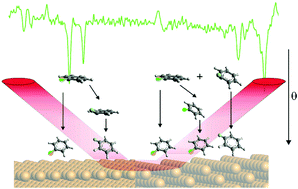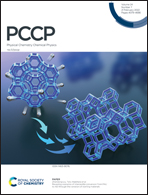Halogen and structure sensitivity of halobenzene adsorption on copper surfaces†
Abstract
The adsorption orientation of molecules on surfaces influences their reactivity, but it is still challenging to tailor the interactions that govern their orientation. Here, we investigate how the substituent and the surface structure alter the adsorption orientation of halogenated benzene molecules from parallel to tilted relative to the surface plane. The deviation of the parallel orientation of bromo-, chloro-, and fluorobenzene molecules adsorbed on Cu(111) and Cu(110) surfaces is determined, utilising the surface selection rule in reflection–absorption infrared spectroscopy. On Cu(111), all three halogenated molecules are adsorbed with their molecular plane almost parallel to the surface at low coverages. However, they are tilted at higher coverages; yet, the threshold coverages differ. On Cu(110), merely bromo- and chlorobenzene follow this trend, albeit with a lower threshold for both. In contrast, fluorobenzene molecules are tilted already at low coverages. The substantial influence of the halogen atom and the surface structure on the adsorption orientation, resulting from an interplay of molecule-molecule and molecule-surface interactions, is highly relevant for reactivity confined to two dimensions.



 Please wait while we load your content...
Please wait while we load your content...
